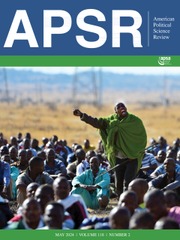Article contents
The Effect of Protesters’ Gender on Public Reactions to Protests and Protest Repression
Published online by Cambridge University Press: 07 March 2024
Abstract
This study examines how protesters’ gender shapes public reactions to protests and protest repression. Using an original survey experiment, I demonstrate that protests involving extensive participation by women are perceived as less violent and meriting of repression than male-dominated protests. But perceptions of female protesters vary. Patriarchy-defiant female protesters like feminists are deemed more deserving of repression despite being perceived as equally likely to be peaceful as female protesters who emphasize patriarchy-compliant femininities, such as women who highlight their roles as mothers and wives. This, I show, is because patriarchy-defiant women are viewed as more immoral, which renders their protest accounts less trustworthy when they clash with government propaganda seeking to legitimize repression. These findings underscore the value of disaggregating the binary category of man or woman when examining sentiments toward political agents and of considering stereotypes when studying perceptions, and ultimately the risks and effectiveness, of protest movements.
- Type
- Research Article
- Information
- Copyright
- © The Author(s), 2024. Published by Cambridge University Press on behalf of American Political Science Association
References
REFERENCES
- 2
- Cited by



Comments
No Comments have been published for this article.